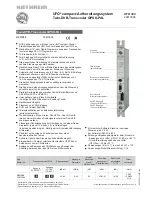
6
Service & Maintenance
31
Series 907 Analog Convection Transducer
Instruction Manual - #109070001
3.
Note the pressure reading. The pressure will either rise or fall, depending upon the thermal
conductivity of the probe gas relative to the system gas. The largest change in value indicates
the probe gas is nearest the leak location.
4.
Repeat the test to confirm.
6.8 Clean the Transducer Case and Sensor
The finish on the 907 Transducer case is designed to resist many laboratory solvents, but it can be
cleaned with water or alcohol.
Roughing pump oils and other fluids condensing or decomposing on the heated filament can
contaminate the sensor, which changes the emissivity of the filament and can cause the calibration
to change, especially at low pressure.
It is not advisable to clean the sensor. Trying to clean it may either deform or break the filament,
which would cause additional error from a shift in the sensor's output. See Section 6.10, Replacing
the Sensor.
6.9 Test the Sensor
1.
Disconnect the power cable from the 907 Transducer.
2.
Remove the two screws from the transducer electronics subassembly. Gently pull the sensor
tube away from the transducer assembly.
3.
With an ohmmeter, check the resistance as specified in Table 6-2 and Figure 6-1. The
resistance readings of a normal sensor measured at atmospheric pressure and room
temperature (20°C) are listed in the middle column. If the condition in the right column exists,
replace the sensor tube. See Section 6.10, Replace the 907 Sensor Tube.
Figure 6-2: Sensor Pins
Table 6-2: Sensor Tube Troubleshooting
Check
Resistance
If the reading is:
F1 to F2
29
Ω
higher, the filament is broken or
burned out.
F1 to sensor port
F2 to sensor port
20 M
Ω
lower, the sensor is damaged or
contaminated.
TC1 to TC2
27
Ω
higher, the temperature compensation
winding is broken.
TC1 to sensor port
TC2 to sensor port
20 M
Ω
lower, the temperature compensation
winding is shorted to the sensor body.








































